27 Top Email Marketing Statistics For 2024 (Latest Industry Data)

Curious about the latest email marketing statistics?
Email marketing is one of the most popular marketing channels, and it’s completely overtaken traditional mail marketing.
In this post, we’ve rounded up the top email marketing statistics from the latest reports published around the web.
These email marketing stats prove what strategies work and what aspects of email marketing marketers feel are most important.
Email marketing statistics – Editor’s picks
Here’s a quick round-up of the email marketing statistics from this list:
- There are 4 billion email accounts around the world. (Statista1)
- Over 300 billion emails get sent every day. (Statista2)
- The average open rate of an email is 21.3%. (Mailchimp1)
- The average click-through of an email is 2.6%. (Mailchimp1)
- Email marketing was the number one marketing channel for 78.3% of marketers in 2022. (Mailmodo)
- The number one struggle for email marketers is standing out in the inbox, according to 37.3% of email senders. (Mailjet)
- Email marketing revenue was $7.5 billion in 2020. (Statista4)
- The newsletter is the most popular campaign type. 83.3% of marketers sent this type of campaign in 2022. (Mailmodo)
- Automation is used by 63% of email marketers. (Statista5)
- The majority of marketers, or 39.4%, send 1 to 4 email campaigns a month. (Mailmodo)
- 35.3% of marketers say Tuesday is the best day of the week to send emails. (Mailmodo)
- 49.5% of marketers say email marketing mostly helps with content distribution. (Mailjet)
- Clicks are 101% higher in segmented campaigns than they are in non-segmented campaigns. (Mailchimp2)
- 29% of email senders perform list cleaning tasks, such as removing inactive subscribers, on a monthly basis. (Mailjet)
General email marketing statistics
1. There are more than 4 billion email users in the world
According to data reported by Statista, there were 4.04 billion email users in the world in 2020.
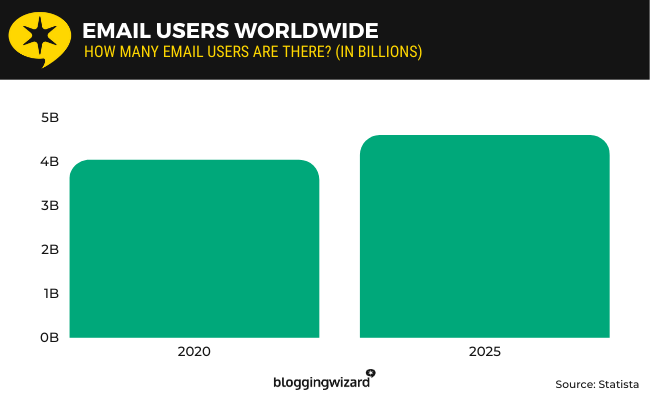
They also reported that there will be 4.6 billion email users by 2025.
Source: Statista1
2. More than 300 billion emails are sent every day around the world
In 2020, 306.4 billion emails were sent around the world on a daily basis.

This stat comes from Statista, who also report that there will be 376.4 billion emails sent every day in 2025.
Source: Statista2
3. 76.8% of marketers agree that email marketing is directly connected to the success of their organizations
Mailjet surveyed 3,200 email senders for their Inbox Insights 2023 report.
They asked respondents whether or not they agreed with the following statement: “Email marketing is directly connected to the success of our organization.”
51.6% somewhat agreed while 25.2% strongly agreed.
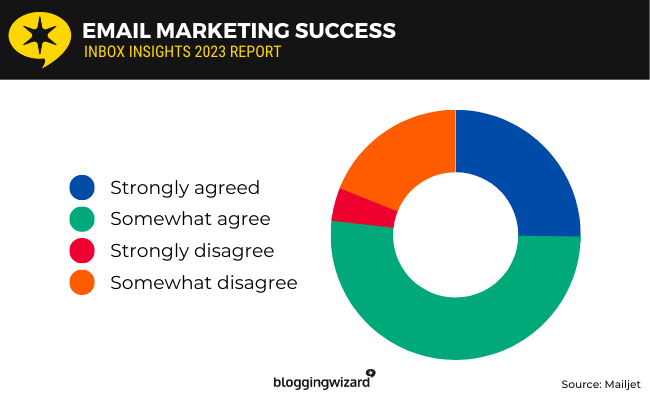
18.9% somewhat disagreed while 4.3% strongly disagreed.
Source: Mailjet
4. The average open rate among all industries is 21.3%
Mailchimp scanned billions of emails sent by its platform on behalf of its customers.
They focused on emails sent by lists that had at least 1,000 subscribers.
They found that the average open rate among all industries was 21.33%.
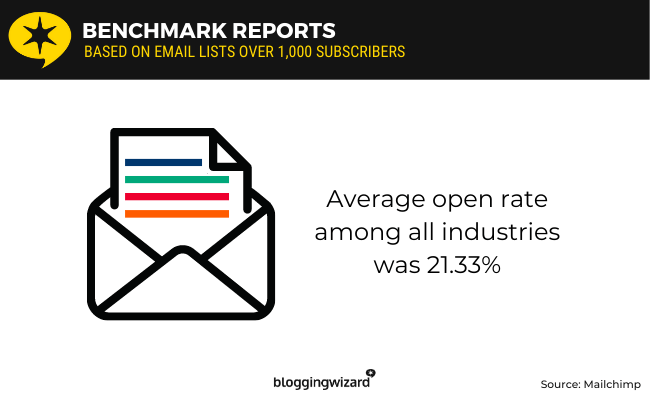
Emails sent by users in government were opened the most at a rate of 28.77%.
Emails sent by daily deal/coupon sites and vitamin supplement companies were opened the least at rates of 15.06 and 15.03% respectively.
Source: Mailchimp1
5. The average click-through rate among all industries is 2.6%
Mailchimp’s benchmark reports also found that the average click-through rate among all industries is 2.62%.
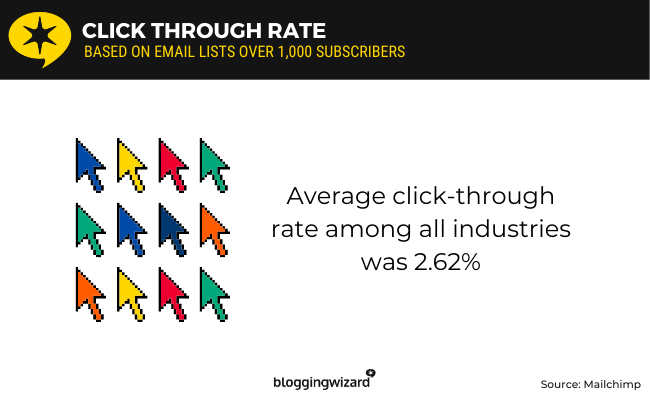
Hobby-related niches have a click-through rate of 5.01%, the highest among all industries.
Click-through rates were lowest among the restaurant niche, which had a click-through rate of 1.34%.
Source: Mailchimp1
6. 78.3% of marketers say email marketing was their top-performing marketing channel in 2022
Mailmodo surveyed over 150 email marketers to produce an extensive report filled with valuable email marketing statistics.
They found that 78.29% reported email marketing as being their number-one performing marketing channel for 2022.
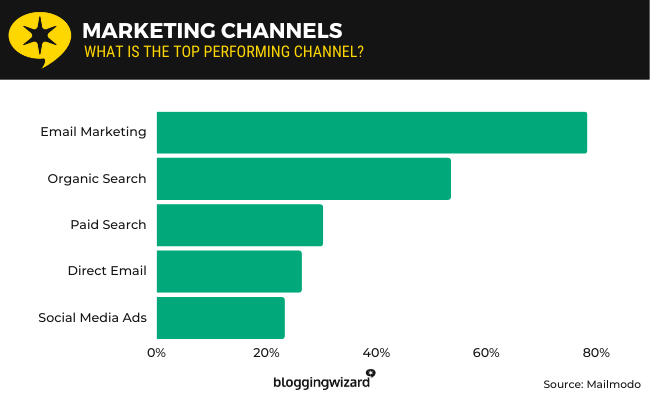
53.49% of marketers said organic search was their top-performing marketing channel while 30.23% said paid search was their top-performing channel.
65.5% of respondents work for B2B companies. 40% work for SaaS companies.
Source: Mailmodo
7. 68% of enterprises in select regions communicate with customers via email
According to data reported by Statista, 68% of enterprises in select regions around the world use email to communicate with customers.
79% use their websites in some type of way to communicate with customers.
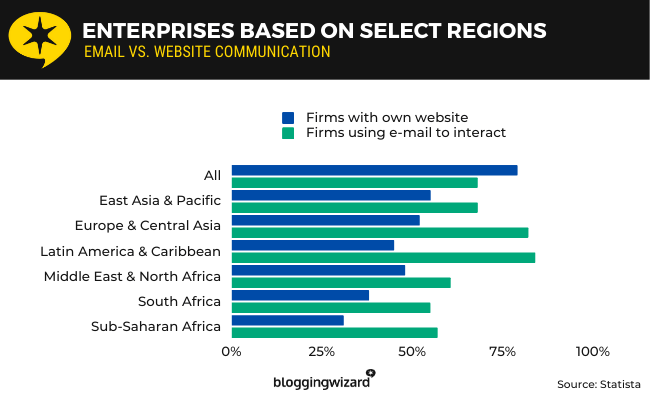
Email is mostly used by the Latin American and Caribbean regions where 84% of enterprises use email to communicate with clients and suppliers.
82% of enterprises in Europe and Central Asia also use email for communication.
Email is used the least in the South Asian region where only 54% of enterprises use it to communicate.
North America, South America, Australia and Oceania were excluded from this data.
Source: Statista3
8. 37.3% of email senders say standing out in the inbox is their biggest struggle with email marketing
Mailjet asked 3,200 email senders about the biggest constraints to the success of their email programs.
Respondents were allowed to select up to three options. 37.3% chose standing out in the inbox.
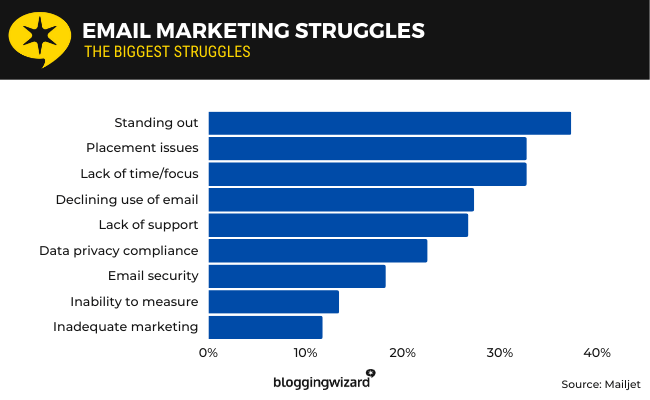
32.7% chose inbox placement while another 32.7% chose lack of time to focus on email marketing.
The smallest issue voted by respondents was inadequate email marketing software. Only 11.7% of respondents chose this option.
Source: Mailjet
Revenue-related email marketing statistics
9. The global email marketing revenue was $7.5 billion in 2020
Statista reports that the market value of the email marketing industry was $7.5 billion in 2020 alone.
That number is expected to reach $17.9 billion by 2027 at a compound annual growth rate (CAGR) of 13.3%.
Source: Statista4
10. 50.8% saw their email marketing ROI double in 2022
Mailmodo asked over 150 email marketers whether or not their returns on investment improved in 2022 and by how much.
50.8% said they doubled their returns on investment from email marketing in 2022.
However, 16.9% saw no improvement.
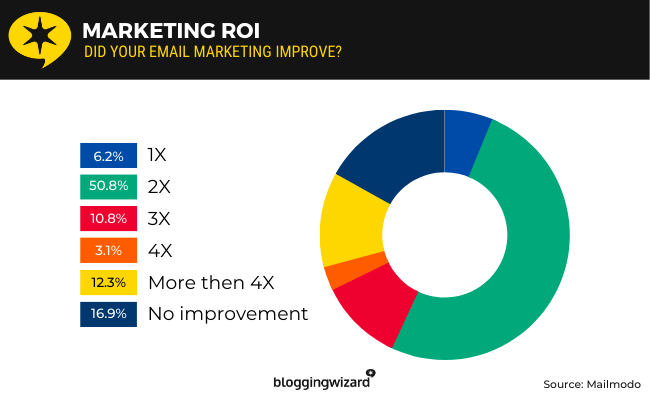
12.3% saw an improvement of four times the amount of the previous year while 10.8% saw an increase of their email marketing ROI of more than three times the amount as the previous year.
Source: Mailmodo
Strategy-based email marketing statistics
11. 83.3% of marketers sent newsletter email campaigns in 2022
Mailmodo asked marketers about the types of email campaigns they sent in 2022.
83.33% of marketers said they sent newsletters in 2022, the most of any email marketing campaign type.

72.73% sent promotional emails while 71.21% sent welcome emails.
The least-used campaign types were milestone emails at 19.7%, cart abandonment emails at 37.88% and cold emails at another 37.88%.
Source: Mailmodo
12. 63% of companies use automation for email marketing
Email marketing is the marketing channel companies are most likely to use automation for.
In a survey of 391 marketing decision makers, 63% said they used marketing automation for email campaigns.
Around 50% use it for social media management while 43% use automation for advertising.
Source: Statista5
13. 39.4% of marketers send 1 to 4 emails to subscribers every month
Mailmodo asked survey respondents about the number of emails they send to their email subscribers every month.
39.4% send one to four emails per month while 36.4% send four to eight emails per month.
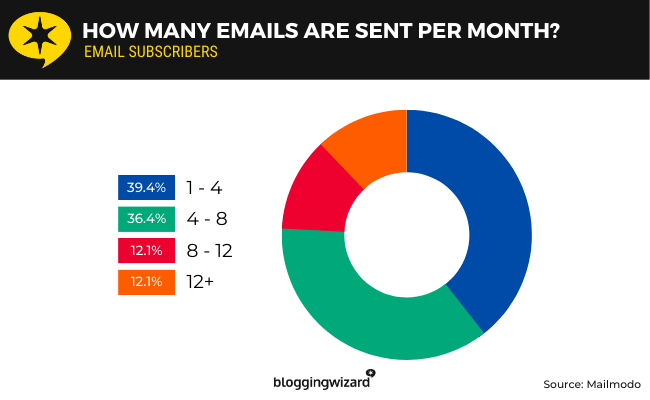
12.1% send eight to 12 emails a month while another 12.1% send more than 12 emails to their email recipients every month.
Source: Mailmodo
14. The best day to send marketing emails is Tuesday, according to 35.3% of marketers
When Mailmodo asked over 150 marketers about their biggest days of the week as far as email engagement goes, 35.3% said Tuesday was the best day to send emails.

Over 25% said Wednesday while less than 10% (each) said Monday, Saturday and Sunday with Saturday receiving the fewest number of votes.
We did our own meta-analysis to find the best email send times based on multiple data sources. Read it here.
Source: Mailmodo
15. Over 40% of marketers say single-column emails perform best
Mailmodo asked over 150 marketers about the email layouts they used in 2022 as well as which ones worked best.
Over 40% said single-column layouts worked best.
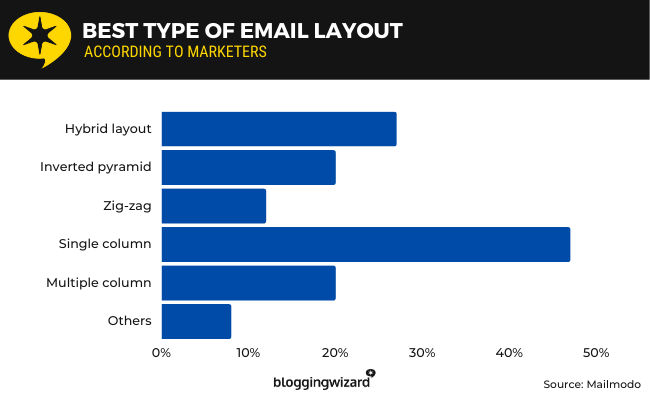
Over 25% reported hybrid layouts as being the best layouts while around 20% said the inverted pyramid layout worked best and another 20% said multi-column layouts worked best.
Source: Mailmodo
16. Over 60% of companies use email marketing for promotional purposes and brand awareness
Mailmodo asked over 150 marketers what their companies used email marketing for the most in 2022.
Over 60% said they used email marketing for awareness/promotional purposes, the most of any email marketing strategy.

However, the survey also revealed that over 70% of marketers will instead focus their attention on using email marketing for customer retention this year.
Source: Mailmodo
17. 49.5% of email senders say email mostly helps with content marketing
In Mailjet’s survey of 3,200 email senders, over 76.8% agreed that email marketing is directly connected to the success of an organization.
44.1% reported being capable of accurately measuring the impact email has on their organizations.
When asked about the most important objectives email helps their organizations achieve, 49.5% chose content distribution (respondents were able to select up to three options).
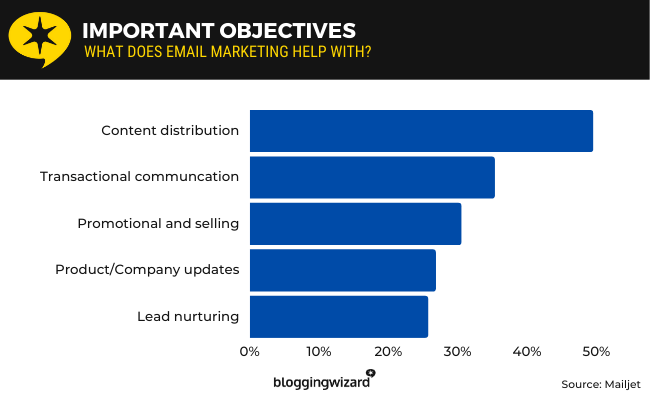
35.3% chose transactional communication, 30.5% chose promotions and selling, 26.8% chose product updates, and 25.7% chose lead nurturing.
The least important object chosen by respondents was re-engagement at 7%.
Source: Mailjet
18. 42.7% of email marketers say open rate is the most important email marketing metric
Mailjet surveyed over 3,200 email senders for their Inbox Insights report for 2023.
They found that 42.7% of email senders believe open rate to be the most important email marketing metric to measure for success.
At a close second was click-through rate, which 42.1% of email senders voted as being the most important email marketing metric.
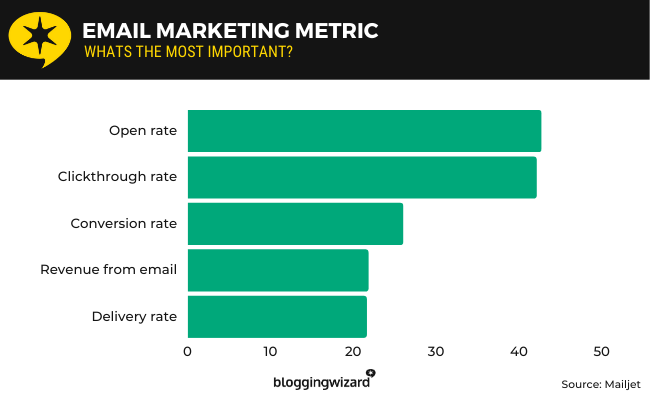
26% chose conversion rate.
An equal number of respondents chose revenue from email (21.8%), delivery rate (21.6%) and click-to-open-rate (21.3%).
Product adoption and customer retention were the least important metrics chosen by respondents at 3.8% and 4.2% respectively.
Source: Mailjet
19. 34.4% of email senders say design and copy are the biggest contributors to the success of an email program
In Mailjet’s survey, the company asked 3,200 email senders about what they feel the biggest contributors to the success of an email program are.
Respondents were able to select up to three options.
34.4% chose design and copy, and another 34.4% chose improving deliverability.
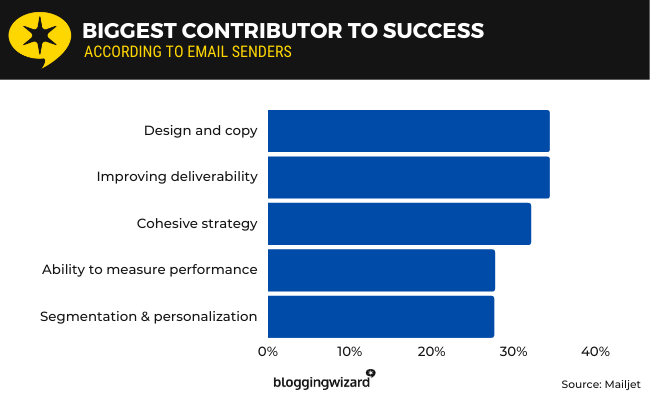
Other important contributors chosen by respondents included having a cohesive strategy (chosen by 32.1% of respondents), return on investment (27.7%), segmentation and personalization (27.6%), and engagement (26.5%).
Respondents chose A/B testing (5.3%) as the least likely contributor to the success of an email program.
Source: Mailjet
20. More than 50% of companies add personalized subject lines to 47.4% of their marketing emails
According to Mailmodo, over 50% of marketers report using personalized subject lines on 47.4% of the emails they sent in 2022.

However, they also found that 36.8% of marketers don’t use subject line personalization at all.
In Mailjet’s survey of 3,200 respondents, 53.1% report using the name of their email recipient for personalization.
30.6% use purchase history, 28% use birthday or subscription anniversary, and 26.2% use location.
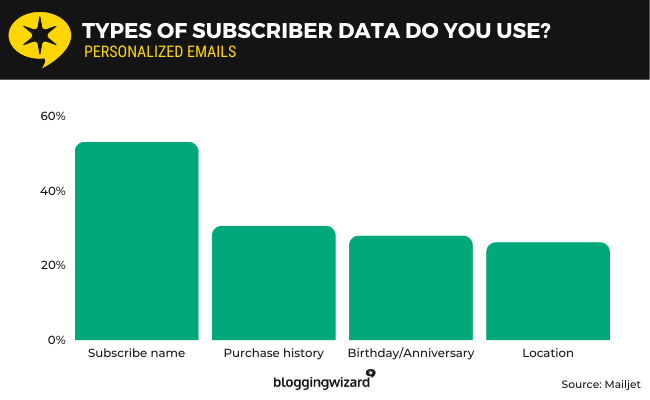
Source: Mailmodo, Mailjet
21. 57.9% of marketers say actionable CTAs perform better than other CTA types
Mailmodo asked over 150 marketers about the types of CTAs they use.
57.9% claim emails with actionable CTAs have higher click-through rates.
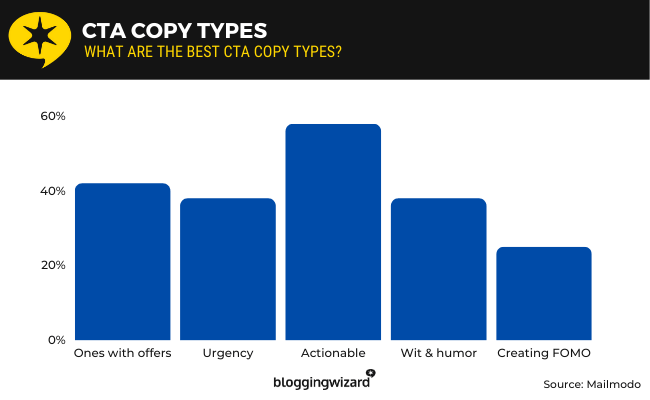
40% say offers and discounts result in higher click-through rates while just shy of 40% companies report urgent and witty CTAs as performing the best each.
Source: Mailmodo
22. Clicks from segmented campaigns are 101% higher than they are from non-segmented campaigns
Mailchimp conducted another analysis of its own data, which was sourced from 2,000 users who used 11,000 segmented campaigns.
They found that clicks were 100.95% higher in segmented campaigns than they were in non-segmented campaigns on average.
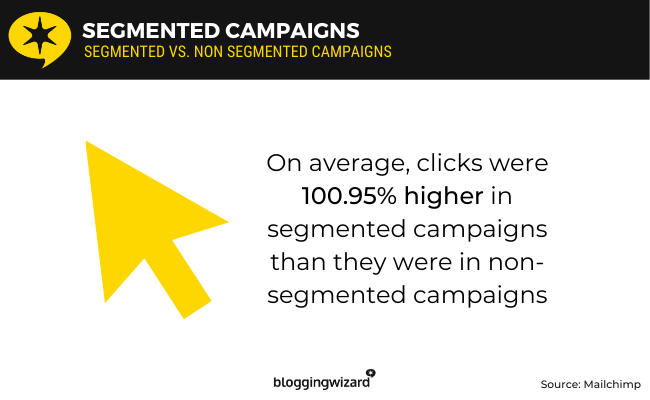
They also found that open rates were 14.3% and unique opens were 10.6% higher.
Bounces, abuse reports and unsubscribes were 4.7%, 3.9% and 9.4% lower respectively.
Source: Mailchimp2
23. 29% of email senders clean their email lists on a monthly basis
Mailjet asked 3,200 email senders about how often they clean their email lists.
29%, the majority, said they clean their email lists on a monthly basis.
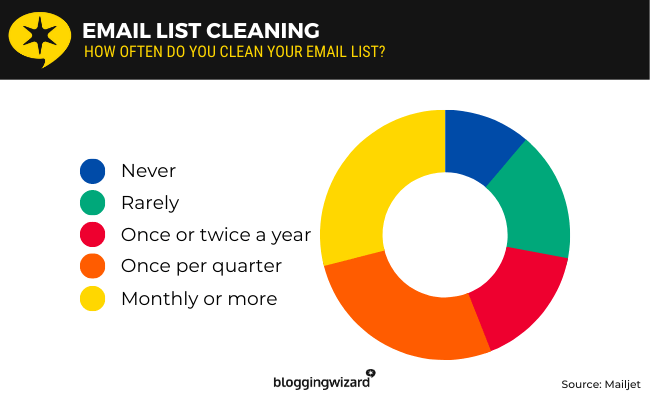
27% clean their lists once per quarter while 16.8% rarely clean their lists.
16% clean their lists once or twice per year while 11.2% never clean their lists.
As far as how email senders clean their lists, 50.4% remove inactive subscribers.

36% remove blocks and spam complaints while 29.3% validate emails at signup.
28.3% send re-engagement campaigns, and 28% use a suppression list.
Source: Mailjet
Misc. statistics (+ mobile email marketing statistics)
24. 40% of marketers create email templates with template creator tools
Mailmodo’s survey revealed that 40% of marketers design emails with email template creator tools.
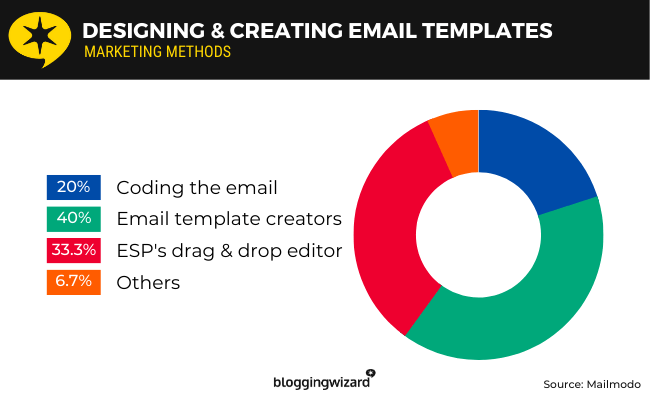
33.3% use their email marketing service provider’s drag-and-drop editor while 20% create their own templates using code.
6.7% use other solutions.
Source: Mailmodo
25. 66.7% of marketers test the responsiveness of emails manually
A majority (66.7%) of marketers test the responsiveness of emails by sending test emails to different mobile devices manually.
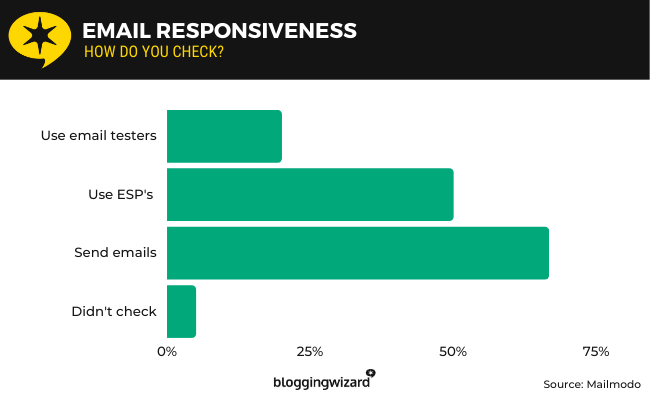
Around 50% use their email marketing service providers’ built-in previewers while around 20% use dedicated tools like Litmus.
Around 5% of respondents don’t check how responsive an email is on a mobile device at all.
Source: Mailmodo
26. 55.9% of marketers say the number of emails opened on mobile devices increased in 2022
In Mailmodo’s survey of over 150 marketers, 55.9% said the number of emails that were opened on mobile devices increased in 2022.
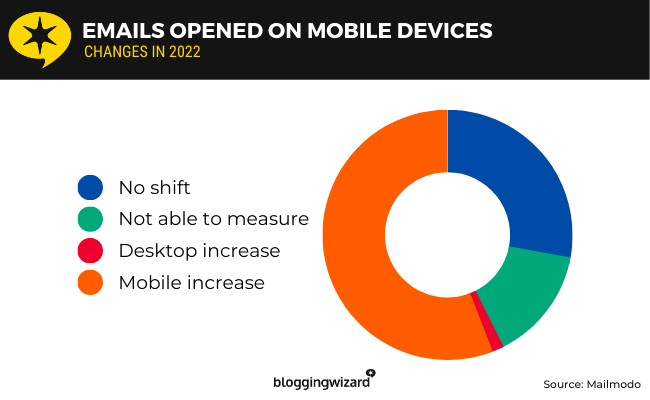
27.9% said they didn’t see an increase at all while 14.7% report not being able to measure this metric.
1.5% actually saw an increase in desktop use as far as opening emails goes.
Source: Mailmodo
27. Nearly 100% of all companies use the Sender Policy Framework (SPF) as an email authentication method
Mailmodo asked over 150 marketers about the email authentication protocols they use.
Nearly 100% use SPF.
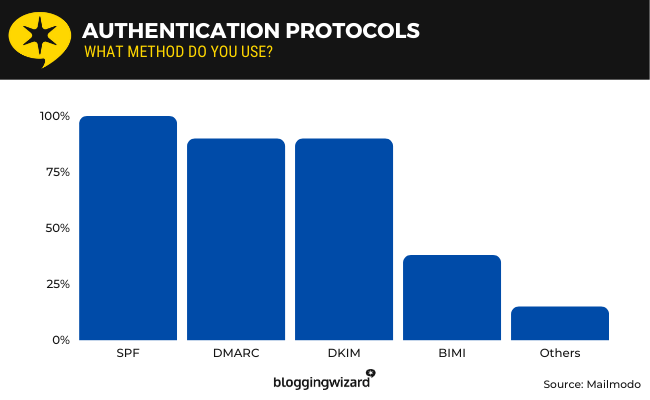
Around 90% use Domain-based Message Authentication Reporting and Conformance (DMARC), and another 90% use DomainKeys Identified Mail (DKIM).
Less than 50% use Brand Indicators for Message Identification (BIMI).
Source: Mailmodo
Sources
Final thoughts
We can spot quite a few trends when we look at these email marketing statistics.
The first is that email marketing is still a popular form of marketing, especially when it comes to promoting content.
We can also see that segmentation is one of the best email marketing strategies you can use yet most email marketers don’t use it or don’t use it properly.
We can tell by the way most email marketers struggle to stand out in the inbox as well as how low the average open and click-through rates are.
We highly suggest getting to know your email marketing service provider’s platform better or switching to an email service that offers better email building and segmentation features than your current provider.
With that said, that wraps up our roundup of the latest email marketing statistics.
If you’d like to dig into more stats, I’d recommend checking out our post on blogging statistics next.
For additional reading:
